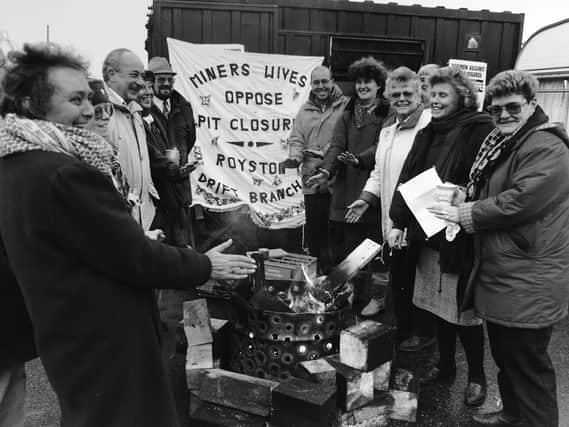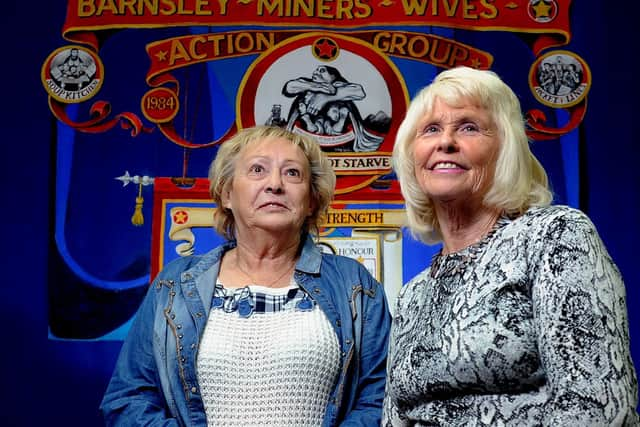Meet Anne Scargill and Betty Cook, two of Yorkshire's prominent figures in the Women Against Pit Closures movement


“I got the feeling that day that working class women like me were finally getting their chance,” writes Betty Cook. “I could see on their faces that there was a determination to fight and try to win this strike, but there was something else as well; I got a sense that it was more than just a strike we were going to win. I think it was the women who first realised that the fight to keep pits open was about the future for our family life, for our children and their children to come.”
It was Saturday, May 12 in 1984 and the biggest gathering of women to ever march through Barnsley took to the streets with homemade placards and banners in hand. Around 3,000 took part, rolling in on coaches from Durham, Kent, Lancashire, even Scotland. Betty was among them, as too was her new friend Anne Scargill, then wife of the president of the National Union of Mineworkers (NUM) – Arthur Scargill.
Advertisement
Hide AdAdvertisement
Hide AdThe pair had met just weeks earlier at a meeting among local women to discuss ways to help the striking miners. From that grew the Women Against Pit Closures movement – and Betty and Anne became two of its leading lights. Their reputation is such that they have been written about many times before, but with the publication of their new book Anne and Betty: United By The Struggle, they are proud to finally tell their story in their own words.


It is a story, Betty says, speaking from her home in Tankersley, Barnsley, of two ordinary women and how involvement in industrial action changed their lives. Co-written by Featherstone author Ian Clayton, the memoir shines a light on the vitality of the pair who, inspired by the working class values that raised them, have continued to stand up for what they believe in and put their arms around those in need of support.
Beginning by telling their experiences of growing up in the coalfields, it goes on to chart their actions during the miners’ strike of 1984-85 and their subsequent involvement in activism at home and abroad in support of workers’ and human rights. “The strike totally changed my life,” Betty reflects. “I wouldn’t miss it for the world. I’d do it all over again except we can’t run as fast as we had to do some days.”
The industrial dispute, still one of the most bitter the nation has ever seen, broke out in March 1984, when the National Coal Board announced plans to close 20 mines, which would result in the loss of tens of thousands of jobs. The NUM and other unions resisted and Arthur Scargill called for nationwide strike action. Around 165,000 miners heeded his words in spite of no national ballot by NUM members.
Advertisement
Hide AdAdvertisement
Hide AdBetty, who grew up in South Elmsall, the daughter of a miner, was working in mail order at the time. She had started her working life as a nurse after leaving school, but gave up that job when she married a miner and brought up her three sons in a pit house in Woolley.
During miners’ strikes in the early 1970s over pay and working conditions, Betty’s then husband had been a flying picket, travelling to collieries across the country to persuade miners to stay away from work. It was a difficult period for her. “He would just come home for a change of clothes then go off again, whilst I was left at home with the three children,” she recalls.
“We struggled - we were cold and we were hungry and I cried a lot during that time. When 84 came along, I knew it was going to be a long strike. I moved from full-time work to part-time because I was determined I wasn’t going to sit and cry during the 84 strike, I was going to get up and get involved.”
Anne had been brought up in Barugh Green in the heart of the Barnsley coalfield. Her father was a miner from a family of colliers and a staunch union man. In fact, Anne first set eyes on Arthur whilst he was paying her father a visit regarding union matters.
Advertisement
Hide AdAdvertisement
Hide AdDuring the course of the year-long strike, Betty and Anne became comrades in arms. Alongside many miners’ wives, they gave every available hour to support the cause, participating in demonstrations, speaking at rallies and raising funds. The women’s movement also organised soup kitchens to help feed hungry and struggling mining families.
“I’d been hungry myself during my marriage and I realised that although we were supporting the men, it was important to support the wives and the children as well,” Betty says. “Because benefits were cut and people were living from hand to mouth, we decided to provide them with good hot meals to help relieve some of the anxiety.”
Betty and Anne were also among women who decided to join the picket lines in a show of solidarity with the striking men. Anne experienced being arrested by the police and on one occasion, Betty had her knee fractured by a policeman’s truncheon – but nothing deterred them.
“I was proud of my involvement,” Betty reflects. “But Anne and myself were two out of hundreds and hundreds of women. I wouldn’t like anyone to think we were the two heroines if you like. All the women that involved themselves were heroines and fought as hard as we did.”
Advertisement
Hide AdAdvertisement
Hide Ad“Without the women, the strike wouldn’t have lasted as long as it did,” she continues. “And if it had been up to women, it wouldn’t have finished when it did. We wanted to keep going, we felt we were very near to victory.”
The strike ended in defeat for the miners, who returned to work without a settlement in March 1985 after NUM delegates voted 98 to 91 to call off the industrial action. The National Coal Board closed 25 pits.
It may not have achieved its aims but for many of those involved in the Women Against Pit Closures movement, the strike was transformative. They found their voice, broke a norm that for years had expected them to conform to traditional caregiving and home maintenance roles, and, for the first time, many became interested and involved in issues around social justice.
“As soon as my mam saw the pit bus coming, she used to have a warm plate and the knives and forks on the table,” Anne writes. “It’s fair to say that some women did go back to that, but most women were changed forever by the strike. They realised that they no longer had to be just a mother or a wife, they had a political education and a wider view.”
Advertisement
Hide AdAdvertisement
Hide AdAnne and Betty were among those who fought again when the Government announced more mine closures in 1992, with women setting up camps outside some of the pits due to be shut down. They have continued to stand up against injustice, supporting causes such as the peace movement and employment rights, and remain good friends to this date.
“We both agree on the same principles - to fight for women and to fight for social justice,” Betty says. “We still go on picket lines if we’re needed. I don’t think that will ever stop.”
Anne & Betty: United By The Struggle, by Pontefract publisher Route, is out now.